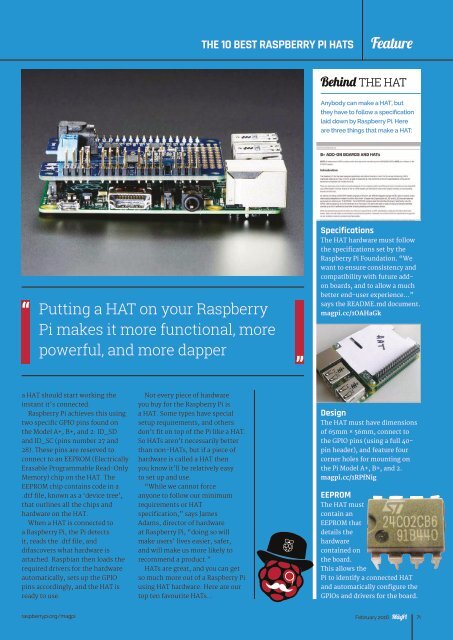Create successful ePaper yourself
Turn your PDF publications into a flip-book with our unique Google optimized e-Paper software.
THE 10 BEST RASPBERRY <strong>PI</strong> HATS<br />
Feature<br />
Behind THE HAT<br />
Anybody can make a HAT, but<br />
they have to follow a specification<br />
laid down by Raspberry Pi. Here<br />
are three things that make a HAT:<br />
Putting a HAT on your Raspberry<br />
Pi makes it more functional, more<br />
powerful, and more dapper<br />
Specifications<br />
The HAT hardware must follow<br />
the specifications set by the<br />
Raspberry Pi Foundation. “We<br />
want to ensure consistency and<br />
compatibility with future addon<br />
boards, and to allow a much<br />
better end-user experience…”<br />
says the README.md document.<br />
magpi.cc/1OAHaGk<br />
a HAT should start working the<br />
instant it’s connected.<br />
Raspberry Pi achieves this using<br />
two specific G<strong>PI</strong>O pins found on<br />
the Model A+, B+, and 2: ID_SD<br />
and ID_SC (pins number 27 and<br />
28). These pins are reserved to<br />
connect to an EEPROM (Electrically<br />
Erasable Programmable Read-Only<br />
Memory) chip on the HAT. The<br />
EEPROM chip contains code in a<br />
.dtf file, known as a ‘device tree’,<br />
that outlines all the chips and<br />
hardware on the HAT.<br />
When a HAT is connected to<br />
a Raspberry Pi, the Pi detects<br />
it, reads the .dtf file, and<br />
difascovers what hardware is<br />
attached. Raspbian then loads the<br />
required drivers for the hardware<br />
automatically, sets up the G<strong>PI</strong>O<br />
pins accordingly, and the HAT is<br />
ready to use.<br />
Not every piece of hardware<br />
you buy for the Raspberry Pi is<br />
a HAT. Some types have special<br />
setup requirements, and others<br />
don’t fit on top of the Pi like a HAT.<br />
So HATs aren’t necessarily better<br />
than non-HATs, but if a piece of<br />
hardware is called a HAT then<br />
you know it’ll be relatively easy<br />
to set up and use.<br />
“While we cannot force<br />
anyone to follow our minimum<br />
requirements or HAT<br />
specification,” says James<br />
Adams, director of hardware<br />
at Raspberry Pi, “doing so will<br />
make users’ lives easier, safer,<br />
and will make us more likely to<br />
recommend a product.”<br />
HATs are great, and you can get<br />
so much more out of a Raspberry Pi<br />
using HAT hardware. Here are our<br />
top ten favourite HATs…<br />
Design<br />
The HAT must have dimensions<br />
of 65mm × 56mm, connect to<br />
the G<strong>PI</strong>O pins (using a full 40-<br />
pin header), and feature four<br />
corner holes for mounting on<br />
the Pi Model A+, B+, and 2.<br />
magpi.cc/1RPfNig<br />
EEPROM<br />
The HAT must<br />
contain an<br />
EEPROM that<br />
details the<br />
hardware<br />
contained on<br />
the board.<br />
This allows the<br />
Pi to identify a connected HAT<br />
and automatically configure the<br />
G<strong>PI</strong>Os and drivers for the board.<br />
raspberrypi.org/magpi February 2016<br />
71


